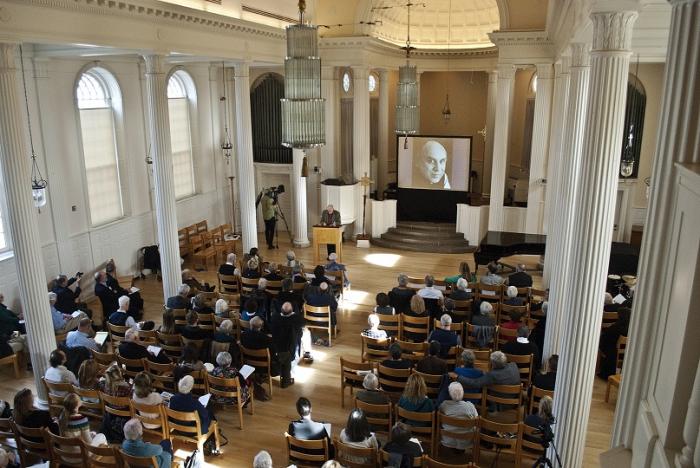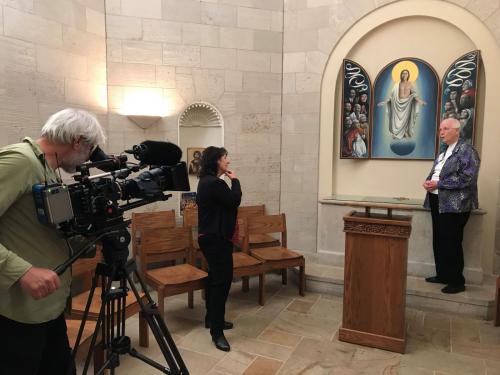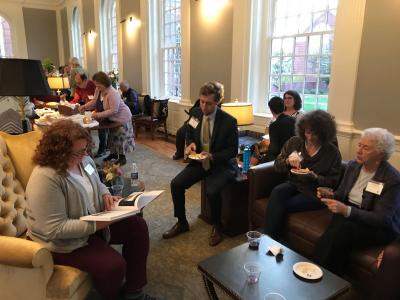By Timothy Cahill ’16 M.A.R.
Thomas Merton and Henri Nouwen were spiritual leaders in an era when the term “spirituality” emerged into mainstream American Christian thought. Through the second half of the twentieth century, Merton and Nouwen were also literary luminaries who inspired millions of readers with their ideas and expression. The enduring relevance of these two masters brought scholars, theologians, clergy, and writers together for a two-day meeting at the Divinity School this past November. The event, “Henri Nouwen & Thomas Merton: Spiritual Guides for the 21st Century,” was as much reunion as conference, bringing together friends and followers who had personally known the spiritual exemplars and continue to celebrate them.

In 1948, as the nation recovered after World War II, Merton all but founded modern American spirituality with the publication of his memoir, The Seven Storey Mountain. Merton’s confession of faith quickly became a best-seller and established him as a voice of conscience and prophecy. Through the 1950s and until his death in 1968, the Trappist monk wrote with prolific force on the life of the soul in subjects from contemplative prayer to political action.
Merton attracted many admirers, among them the Dutch-born Henri Nouwen. A priest, educator, and writer who was inspired by the older author (Merton was born in 1915; Nouwen in 1932), Nouwen developed a deeply compassionate strain of pastoral theology that combined psychology and spirituality. Nouwen was the bard of spiritual self-care and popularizer of the concept of the “wounded healer,” the caregiver who learns to relieve the pain of others by confronting his or her own emotional wounds.
Merton remains a spiritual superstar, named in 2015 by Pope Francis as one of the four most inspirational figures in American history (with Abraham Lincoln, Martin Luther King, and Dorothy Day). At the conference, however, Nouwen was the favorite son, as YDS alumni reminisced about the decade from 1971 to 1981 when he was a professor at the Divinity School. Former students fondly recalled a popular seminar Nouwen taught on Merton, in which he beseeched students to buy all of the Trappist’s books so they could forever be sustained by “a whole shelf of his work.”
 Nouwen’s presence is still strong at the school. A scholarship is named in his honor, and there is no better place to channel his spirit than in the Henri Nouwen Prayer Chapel, on the ground level of the Divinity Library. The intimate, octagonal stone sanctuary, the site of worship services, homiletics seminars, even, once, an art installation, is dominated by an altarpiece painted by priest and artist John Giuliani in honor of Nouwen. The triptych depicts a distinctly Native American Christ reigning in glory, attended on the wings by portraits of Henri’s spiritual guides, figures ranging from Teresa of Avila to Teresa of Calcutta, Mahatma Gandhi to Oscar Romero, Cardinal Newman to Vincent van Gogh, and including Merton, King, Day, and Nouwen himself.
Nouwen’s presence is still strong at the school. A scholarship is named in his honor, and there is no better place to channel his spirit than in the Henri Nouwen Prayer Chapel, on the ground level of the Divinity Library. The intimate, octagonal stone sanctuary, the site of worship services, homiletics seminars, even, once, an art installation, is dominated by an altarpiece painted by priest and artist John Giuliani in honor of Nouwen. The triptych depicts a distinctly Native American Christ reigning in glory, attended on the wings by portraits of Henri’s spiritual guides, figures ranging from Teresa of Avila to Teresa of Calcutta, Mahatma Gandhi to Oscar Romero, Cardinal Newman to Vincent van Gogh, and including Merton, King, Day, and Nouwen himself.
For me, as for so many YDS alumni I met there, the conference was a homecoming, not just to the Sterling Divinity Quadrangle but into a circle of like-minded spiritual seekers. We shared an intensive two days of impressions and encounters, testimony and reflection, thanks and praise, for these two avatars of Christianity’s aesthetic, affective heart.
“Merton is a combination of Bob Dylan, Leonard Cohen, and John Coltrane. He’s a robust voice who speaks to the strong,” declared Ron Rolheiser in his Friday keynote address, drawing a powerful distinction between the conference’s two subjects. “Nouwen speaks for the soul and the unheard. He never hid his weaknesses from his readers. It’s like he’s speaking into your ear.”
“Henri Nouwen wanted to be a saint, but he also wanted to live as a man, even as a sinner,” the Catholic priest and writer continued. “He was always a saint in progress.”
 Following Rolheiser’s talk, more than fifty people gathered for a reception in the newly renovated Old Common Room. There I met author Jim Forest, who was friends with Merton and Nouwen and has written extensively about both men. He told me about hitchhiking to meet Merton at the Abbey of Gethsemane in the winter of 1961, where he first heard the monk’s “truck-stopping laugh.” Our conversation folded into a larger one convened by Jim Hackney ’79 M.A.R., YDS Senior Development Director, who held a microphone and invited alums to share their memories of Nouwen at Yale. What emerged from the succession of speakers was the portrait of a man who celebrated daily Mass, hosted a weekly gathering with students over wine and theology in his apartment, and, as one former student put it, “spoke to my heart a way no one had ever spoken to it.” Alumni praised Nouwen for inspiring social conscience, including acts of civil disobedience (and, once, arrest) at the Naval Submarine Base in New London, Conn.
Following Rolheiser’s talk, more than fifty people gathered for a reception in the newly renovated Old Common Room. There I met author Jim Forest, who was friends with Merton and Nouwen and has written extensively about both men. He told me about hitchhiking to meet Merton at the Abbey of Gethsemane in the winter of 1961, where he first heard the monk’s “truck-stopping laugh.” Our conversation folded into a larger one convened by Jim Hackney ’79 M.A.R., YDS Senior Development Director, who held a microphone and invited alums to share their memories of Nouwen at Yale. What emerged from the succession of speakers was the portrait of a man who celebrated daily Mass, hosted a weekly gathering with students over wine and theology in his apartment, and, as one former student put it, “spoke to my heart a way no one had ever spoken to it.” Alumni praised Nouwen for inspiring social conscience, including acts of civil disobedience (and, once, arrest) at the Naval Submarine Base in New London, Conn.
Saturday offered breakout sessions on Merton and Nouwen as, among other things, “Men of Letters,” “Spiritual Masters,” and “Sacred Disruptors.” I pursued their somewhat lesser-known identities as mentors of visual art. Paul Pearson, director of the Thomas Merton Center (which co-hosted the conference with the Henri Nouwen Society and YDS), presented a slide show tracing Merton’s lifelong practice as an artist. In the 1930s, as a student at Columbia University, Merton “identified himself as a cartoonist and writer,” and for a time considered a career as a comic artist. He continued to draw throughout his life, but as his contemplative vision grew, he moved ever farther from his early satirical sensibilities, ultimately rejecting both narrative and “prettiness” in his art. As a monk, Merton created a series of what he termed “calligraphies,” ink-wash abstractions reminiscent of Zen brush drawings.
Merton’s abstractions were not created as works of art, Pearson said, but as “simple signs and ciphers of energy.” They reflected the artist’s growth toward apophatic spirituality, a knowledge of the divine that can never be fully expressed through depiction or definition. This theological “negative way,” with roots in the desert ascetics and medieval mystics, comprehends God best when God is incomprehensible. This awareness is also present in the “Zen photography” Merton created in the 1960s. His black-and-white photographs of bare trees, blank walls, and empty rooms record what is visible—the fall of light—to evoke the ineffable.
Nouwen was not an artist himself, but he used art as a portal to spiritual growth. He wrote a book on Rembrandt’s masterpiece Return of the Prodigal Son, and at Yale taught a seminar on the paintings of Vincent van Gogh, which future van Gogh scholar Carol Berry, then a young theology student, was fortunate enough to take. Berry was unable to attend the conference, so her husband, Steve Berry, delivered a lecture in her stead titled “Henri and Vincent,” based on his wife’s forthcoming memoir about the Nouwen seminar.
“Someone can have a fire in their heart, but no one comes to warm themselves by it,” van Gogh wrote to his brother Theo. Nouwen’s class reached out precisely for this warmth. He used van Gogh’s paintings, with all their love, exuberance, and struggle, to illustrate what Nouwen called “the movement of the compassionate life,” progressing in stages from “solidarity” to “consolation” to “comfort.” The first stage, as illustrated in van Gogh’s famous painting Potato Eaters, expresses a sense of common humanity. “Consolation,” Nouwen’s second stage, arrives when we abandon the desire to be different to walk cum solo, “with the lonely other.” The final stage, of “comfort,” points beyond the struggle of daily life to the strength to love that Nouwen saw in paintings like van Gogh’s Starry Night.
 The depths of sacred iconography were the subject of Jim Forest’s address on Nouwen and Merton as “Western Explorers in the Christian East.” Merton’s Christ, Forest said, was “the Christ of the Byzantine icons.” The icon tradition, at once abstract and confrontational, has long been formulated around a “theology of light” transmitted from master to student across generations. This succession of sight and insight connected Merton to the very origins of Christianity.
The depths of sacred iconography were the subject of Jim Forest’s address on Nouwen and Merton as “Western Explorers in the Christian East.” Merton’s Christ, Forest said, was “the Christ of the Byzantine icons.” The icon tradition, at once abstract and confrontational, has long been formulated around a “theology of light” transmitted from master to student across generations. This succession of sight and insight connected Merton to the very origins of Christianity.
Similarly, for Nouwen the icon was a “school of seeing,” Forest said. Andrei Rublev’s renowned thirteenth-century “Holy Trinity” possessed for Nouwen a “directness and sobriety” that “defines the sacred and instructs the faithful.” Forest observed that Nouwen considered every holy icon an image of God, making every individual a “living icon.” Contemplation of icons, Forest said, is a key way for the devout to “cross the border from [spiritual] tourist to pilgrim.”
Pilgrimage had been a theme in Saturday morning’s plenary speech as well. Robert Ellsberg, publisher of Orbis Books, spoke of the “restless journeys” of Merton and Nouwen, describing both men as lifelong pilgrims, spiritually and literally traveling to draw closer to Christ. Ellsberg noted that Merton habitually moved between his devotion as a hermit and his activity as a public man, equally involved in his vocation and the fate of the world. Nouwen, Ellsberg said, was a “spiritual explorer” whose pilgrimage took him from the pulpit to the classroom, and from there to the distressed extremes of life among the poor in South and Central America and the developmentally disabled in L’Arche communities in Europe and Canada.
Merton and Nouwen both died while traveling, Ellsberg observed. Merton was accidentally electrocuted at a conference on East-West spirituality in Bangkok, and Nouwen suffered a heart attack in Holland while filming a documentary about Rembrandt. That they ended their days far from home is poignant, to be sure. But, Ellsberg suggested, it is also fitting that both departed life while pursuing pilgrimages of ministry. What more appropriate end for these constantly seeking souls than to leave in the middle of a journey?
Timothy Cahill ’16 M.A.R. writes on art and religion in public life.